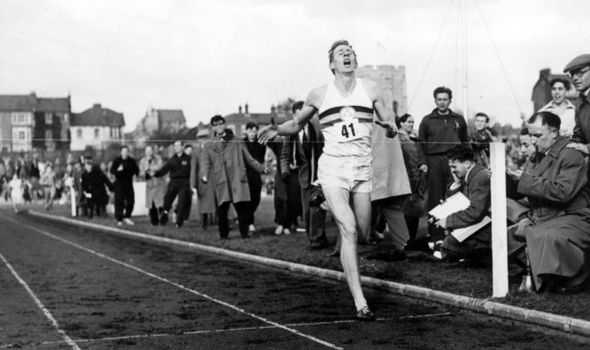When I was a young boy, one of my most cherished books was One Hundred Greatest Sports Heroes. The pages were filled with heroes’ accomplishments. Often, having overcome great adversity, these sports heroes exhibited great resiliency. Today, I wonder what other mindset traits contributed to their success?
Roger Bannister, the first man to run a four-minute mile, died last Saturday. He was one of the “100 greatest”; I returned to his chapter many times. Bannister’s mindset strengths are legendary and can inspire us all.
In Bannister’s day, for a human to run a mile in four minutes was thought to be impossible. Runners were warned against even trying. Another great English runner and Olympic champion Sebastian Coe explained the belief barrier that Bannister had to break: “Not only was it seen as a physiological, physical, mental barrier but learned treaties in medical journals basically saying if anyone tries this then there’s a chance they may lose their life in the process.”
In 1954, Roger Bannister broke that belief barrier. Bannister, because he did not share the same belief system as others, was able to develop new training methods, methods he had to fit to his strict schedule as a medical student.
Running the first four-minute mile, Bannister shattered an unquestioned belief about the limits of human performance.
Looking back at his miraculous run in unfavorable weather Bannister reflected, “The earth seemed to move with me. I found a new source of power and beauty, a source I never knew existed.”
Coe reports that Bannister was always learning, “always interested in training techniques, altitude training, why we were running quicker and faster…Conversations could go anywhere. He was always full of questions.”
In other words, Roger Bannister never went to seed. His life story is a lesson in self-renewal.
How to Not Go to Seed
In his book, Self-Renewal John W. Gardner tries to answer “the puzzle of why some men and women go to seed while others remain vital all of their lives.”
“Exploration of the full range of his own potentialities is not something that the self-renewing man leaves to the chances of life.” Gardner explains, “It is something he pursues systematically, or at least avidly, to the end of his days.”
To be sure, Gardner’s standard for self-renewal is not that we become a champion like Roger Bannister. In a 1990 speech, Gardner made clear that self-renewal is for everybody, including “people who fail to get to the top in achievement.” Gardner continued, “We can’t all get to the top, and that isn’t the point of life anyway. I’m talking about people who — no matter how busy they seem to be — have stopped learning or growing. Many of them are just going through the motions.”
One way we go to seed is by clinging to rigid beliefs. Gardner warns, “We can’t write off the danger of complacency, growing rigidity, imprisonment by our own comfortable habits and opinions. Look around you. How many people whom you know well — people even younger than yourselves –are already trapped in fixed attitudes and habits.”
Going beyond rigid beliefs is at the heart of Bannister’s legacy. Chris Chavez eulogizing Bannister in Sports Illustrated said this, “The first sub-four-minute mile remains one of the greatest achievements of the 20th century. It opened the floodgates to something people believes to be physiologically impossible and broke down the walls of what our minds believed could be accomplished.”
“Limits,” Bannister showed, “are just a creation in our minds,” Chavez tells us. Bannister didn’t stop there; he continued to be a life-long learner.
Learning is not just becoming more skilled. “You come to understand your impact on others,” Gardner advised, and so you develop your character:
“The things you learn in maturity aren’t simple things such as acquiring information and skills. You learn not to engage in self-destructive behavior. You learn not to burn up energy in anxiety. You discover how to manage your tensions, if you have any, which you do. You learn that self-pity and resentment are among the most toxic of drugs. You find that the world loves talent, but pays off on character.”
Bannister ran, not for personal glory, but instead “so that others might follow.” Within four years of his 1954 race, sixteen other athletes ran the mile in under four minutes. Today even high school students can run four-minute miles.
“Don’t believe,” Gardner cautions, “that there is a point at which…[you] have arrived.” There is no scoring system “that tells us when we’ve piled up enough points to count ourselves successful.” Instead, Gardner advised us to see life as providing endless opportunities to discover and renew:
“Life is an endless unfolding, and if we wish it to be, an endless process of self-discovery, an endless and unpredictable dialogue between our own potentialities and the life situations in which we find ourselves. By potentialities I mean not just intellectual gifts but the full range of one’s capacities for learning, sensing, wondering, understanding, loving and aspiring.”
Bannister, Chavez writes, “always felt more proud of his accomplishments in medicine than his work on the track.” Bannister “became a world renowned neurologist” and “was knighted in 1975 for his work in researching the failures of the autonomic nervous system.”
Roger Bannister lived a life “of endless unfolding.” Not only is he one of the “100 greatest sports heroes,” he is a role model for us all.
—
Image Credit: YouTube

















Leave a Comment
Your email address will not be published. Required fields are marked with *